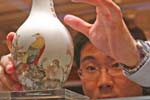From Overseas Press
South China's new labor paradigm
Updated: 2011-04-08 14:02
(Agencies)
When millions of workers didn't return to their southern China factory jobs after Lunar New Year holidays, a turning point was reached for foreign manufacturers scraping by with slim profit margins.
Companies were already under pressure from rising raw material costs, restive workers and lower payments for exports because of a stronger Chinese currency. Despite hiking wages, labor shortages kept getting worse as workers increasingly spurned the often repetitive and unskilled jobs that helped earn China its reputation as the world's low-cost factory floor.
A wave of export manufacturers, big and small, are moving from China's coastal manufacturing regions to cheaper inland provinces or out of the country altogether, in a clear sign that southern China's days as a low-cost manufacturing powerhouse are numbered.
China watchers at Credit Suisse, an investment bank, call the shift an "historical turning point" for China's economy and perhaps the world as the country's role in keeping global inflation low by supplying cheap goods is set to end.
The ripple effects of rising costs in China are already being felt around the globe. US clothing retailers are raising prices for shirts and other garments by 10 percent on average after a decade of price falls, partly due to higher labor costs in China.
Economists say it's the result of a rapidly aging population after 40 years of the family planning policy. Economic growth is "creating more jobs faster than the population is creating new workers," said Stephen Green, an economist at Standard Chartered, in a report titled "Wanted: 25 million workers."
China's blistering growth has also lifted incomes and created more opportunities in poorer inland provinces, which means fewer people leaving for jobs in the richer coastal cities.
Specials

Share your China stories!
Foreign readers are invited to share your China stories.

Art auctions
China accounted for 33% of global fine art sales.

Waiting for drivers' seat
Lack of sponsorship appears to be why Chinese drivers have yet to race in a Formula 1 event